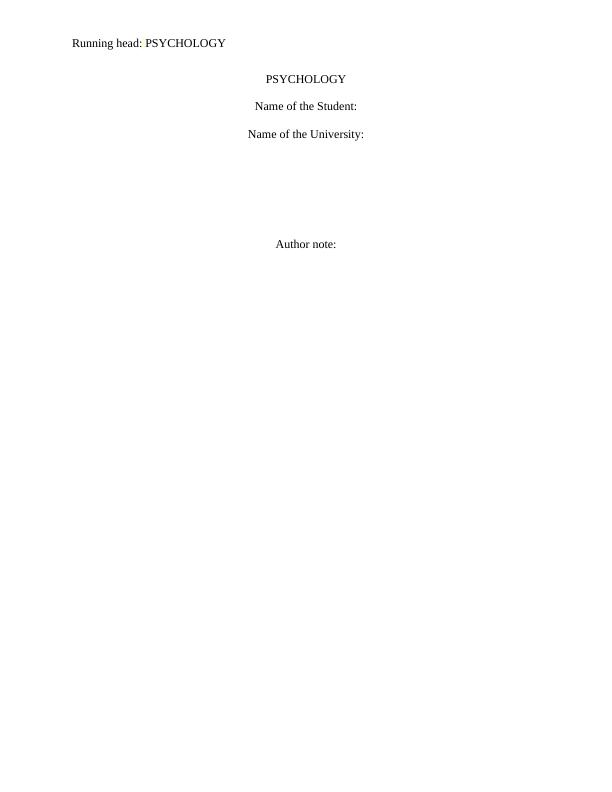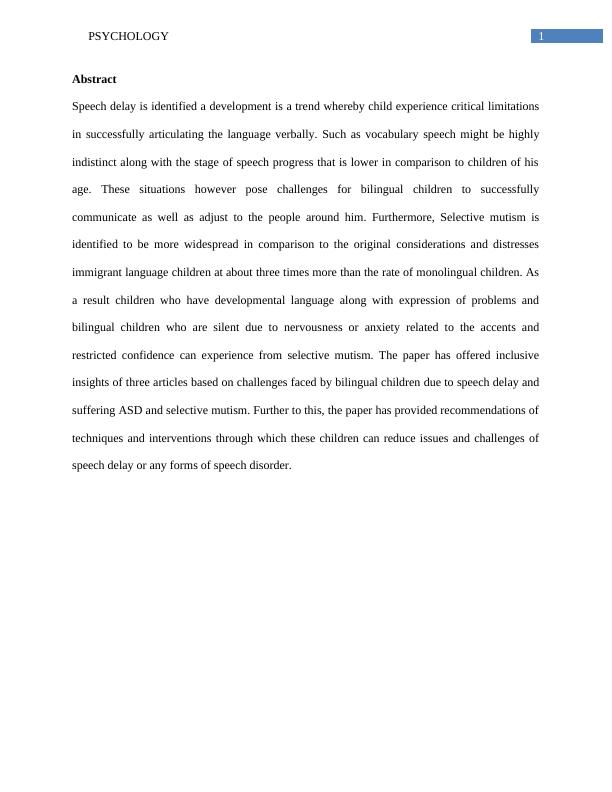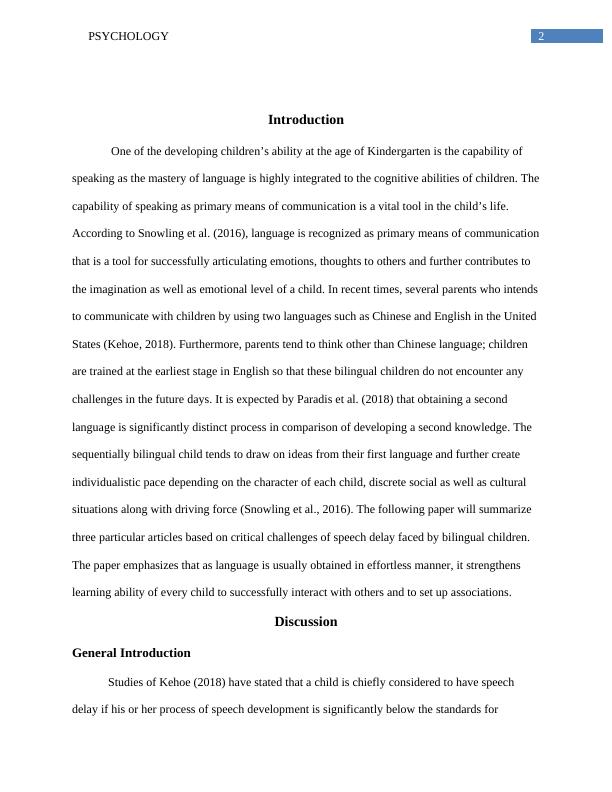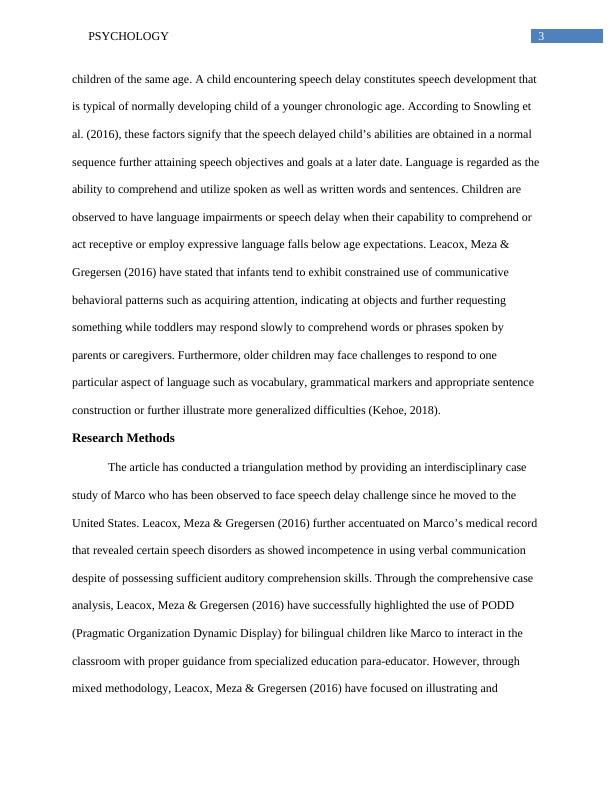Challenges Faced by Bilingual Children with Speech Delay and Selective Mutism: Insights and Recommendations
Added on 2023-05-28
11 Pages2860 Words265 Views
Running head: PSYCHOLOGY
PSYCHOLOGY
Name of the Student:
Name of the University:
Author note:
PSYCHOLOGY
Name of the Student:
Name of the University:
Author note:

1PSYCHOLOGY
Abstract
Speech delay is identified a development is a trend whereby child experience critical limitations
in successfully articulating the language verbally. Such as vocabulary speech might be highly
indistinct along with the stage of speech progress that is lower in comparison to children of his
age. These situations however pose challenges for bilingual children to successfully
communicate as well as adjust to the people around him. Furthermore, Selective mutism is
identified to be more widespread in comparison to the original considerations and distresses
immigrant language children at about three times more than the rate of monolingual children. As
a result children who have developmental language along with expression of problems and
bilingual children who are silent due to nervousness or anxiety related to the accents and
restricted confidence can experience from selective mutism. The paper has offered inclusive
insights of three articles based on challenges faced by bilingual children due to speech delay and
suffering ASD and selective mutism. Further to this, the paper has provided recommendations of
techniques and interventions through which these children can reduce issues and challenges of
speech delay or any forms of speech disorder.
Abstract
Speech delay is identified a development is a trend whereby child experience critical limitations
in successfully articulating the language verbally. Such as vocabulary speech might be highly
indistinct along with the stage of speech progress that is lower in comparison to children of his
age. These situations however pose challenges for bilingual children to successfully
communicate as well as adjust to the people around him. Furthermore, Selective mutism is
identified to be more widespread in comparison to the original considerations and distresses
immigrant language children at about three times more than the rate of monolingual children. As
a result children who have developmental language along with expression of problems and
bilingual children who are silent due to nervousness or anxiety related to the accents and
restricted confidence can experience from selective mutism. The paper has offered inclusive
insights of three articles based on challenges faced by bilingual children due to speech delay and
suffering ASD and selective mutism. Further to this, the paper has provided recommendations of
techniques and interventions through which these children can reduce issues and challenges of
speech delay or any forms of speech disorder.

2PSYCHOLOGY
Introduction
One of the developing children’s ability at the age of Kindergarten is the capability of
speaking as the mastery of language is highly integrated to the cognitive abilities of children. The
capability of speaking as primary means of communication is a vital tool in the child’s life.
According to Snowling et al. (2016), language is recognized as primary means of communication
that is a tool for successfully articulating emotions, thoughts to others and further contributes to
the imagination as well as emotional level of a child. In recent times, several parents who intends
to communicate with children by using two languages such as Chinese and English in the United
States (Kehoe, 2018). Furthermore, parents tend to think other than Chinese language; children
are trained at the earliest stage in English so that these bilingual children do not encounter any
challenges in the future days. It is expected by Paradis et al. (2018) that obtaining a second
language is significantly distinct process in comparison of developing a second knowledge. The
sequentially bilingual child tends to draw on ideas from their first language and further create
individualistic pace depending on the character of each child, discrete social as well as cultural
situations along with driving force (Snowling et al., 2016). The following paper will summarize
three particular articles based on critical challenges of speech delay faced by bilingual children.
The paper emphasizes that as language is usually obtained in effortless manner, it strengthens
learning ability of every child to successfully interact with others and to set up associations.
Discussion
General Introduction
Studies of Kehoe (2018) have stated that a child is chiefly considered to have speech
delay if his or her process of speech development is significantly below the standards for
Introduction
One of the developing children’s ability at the age of Kindergarten is the capability of
speaking as the mastery of language is highly integrated to the cognitive abilities of children. The
capability of speaking as primary means of communication is a vital tool in the child’s life.
According to Snowling et al. (2016), language is recognized as primary means of communication
that is a tool for successfully articulating emotions, thoughts to others and further contributes to
the imagination as well as emotional level of a child. In recent times, several parents who intends
to communicate with children by using two languages such as Chinese and English in the United
States (Kehoe, 2018). Furthermore, parents tend to think other than Chinese language; children
are trained at the earliest stage in English so that these bilingual children do not encounter any
challenges in the future days. It is expected by Paradis et al. (2018) that obtaining a second
language is significantly distinct process in comparison of developing a second knowledge. The
sequentially bilingual child tends to draw on ideas from their first language and further create
individualistic pace depending on the character of each child, discrete social as well as cultural
situations along with driving force (Snowling et al., 2016). The following paper will summarize
three particular articles based on critical challenges of speech delay faced by bilingual children.
The paper emphasizes that as language is usually obtained in effortless manner, it strengthens
learning ability of every child to successfully interact with others and to set up associations.
Discussion
General Introduction
Studies of Kehoe (2018) have stated that a child is chiefly considered to have speech
delay if his or her process of speech development is significantly below the standards for

3PSYCHOLOGY
children of the same age. A child encountering speech delay constitutes speech development that
is typical of normally developing child of a younger chronologic age. According to Snowling et
al. (2016), these factors signify that the speech delayed child’s abilities are obtained in a normal
sequence further attaining speech objectives and goals at a later date. Language is regarded as the
ability to comprehend and utilize spoken as well as written words and sentences. Children are
observed to have language impairments or speech delay when their capability to comprehend or
act receptive or employ expressive language falls below age expectations. Leacox, Meza &
Gregersen (2016) have stated that infants tend to exhibit constrained use of communicative
behavioral patterns such as acquiring attention, indicating at objects and further requesting
something while toddlers may respond slowly to comprehend words or phrases spoken by
parents or caregivers. Furthermore, older children may face challenges to respond to one
particular aspect of language such as vocabulary, grammatical markers and appropriate sentence
construction or further illustrate more generalized difficulties (Kehoe, 2018).
Research Methods
The article has conducted a triangulation method by providing an interdisciplinary case
study of Marco who has been observed to face speech delay challenge since he moved to the
United States. Leacox, Meza & Gregersen (2016) further accentuated on Marco’s medical record
that revealed certain speech disorders as showed incompetence in using verbal communication
despite of possessing sufficient auditory comprehension skills. Through the comprehensive case
analysis, Leacox, Meza & Gregersen (2016) have successfully highlighted the use of PODD
(Pragmatic Organization Dynamic Display) for bilingual children like Marco to interact in the
classroom with proper guidance from specialized education para-educator. However, through
mixed methodology, Leacox, Meza & Gregersen (2016) have focused on illustrating and
children of the same age. A child encountering speech delay constitutes speech development that
is typical of normally developing child of a younger chronologic age. According to Snowling et
al. (2016), these factors signify that the speech delayed child’s abilities are obtained in a normal
sequence further attaining speech objectives and goals at a later date. Language is regarded as the
ability to comprehend and utilize spoken as well as written words and sentences. Children are
observed to have language impairments or speech delay when their capability to comprehend or
act receptive or employ expressive language falls below age expectations. Leacox, Meza &
Gregersen (2016) have stated that infants tend to exhibit constrained use of communicative
behavioral patterns such as acquiring attention, indicating at objects and further requesting
something while toddlers may respond slowly to comprehend words or phrases spoken by
parents or caregivers. Furthermore, older children may face challenges to respond to one
particular aspect of language such as vocabulary, grammatical markers and appropriate sentence
construction or further illustrate more generalized difficulties (Kehoe, 2018).
Research Methods
The article has conducted a triangulation method by providing an interdisciplinary case
study of Marco who has been observed to face speech delay challenge since he moved to the
United States. Leacox, Meza & Gregersen (2016) further accentuated on Marco’s medical record
that revealed certain speech disorders as showed incompetence in using verbal communication
despite of possessing sufficient auditory comprehension skills. Through the comprehensive case
analysis, Leacox, Meza & Gregersen (2016) have successfully highlighted the use of PODD
(Pragmatic Organization Dynamic Display) for bilingual children like Marco to interact in the
classroom with proper guidance from specialized education para-educator. However, through
mixed methodology, Leacox, Meza & Gregersen (2016) have focused on illustrating and

End of preview
Want to access all the pages? Upload your documents or become a member.
Related Documents
Play Therapy And Neonatal Abstinence Syndrome docx.lg...
|8
|2051
|28
Nursing Philosophy and Professional Relationshipslg...
|2
|766
|290
